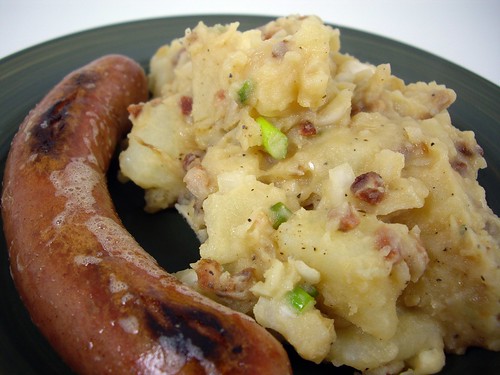Of course, I was given much grief about it from my husband. His usual response (though genuinely supportive of my endeavors) has always been apprehension whenever there is a lack of spices required in a meal. However, either because of his fatigue after a long day at work, his endless affection for me, or the hope that the meal would fail (enabling take-out to be an option), he succumbed to my experiment and we ate as Germans do (much to his chagrin).
Making the cod and mustard sauce was extremely easy. I doubt there would be a kitchen novice who would have much difficulty with this dish. The spaetzle, on the other hand, has quite a learning curve indeed. Often served instead of potatoes or noodles, it is more commonly paired with beef or pork. Of course, with that said, I doubt there are any laws that disallow its use with fish. And, after you get over the daunting hurdle of making spaetzle once, or I should say once you know what to expect when making it, it's really not as hard as it seems. They are like buttery, dumpling-like noodles, with a taste similar to Italian gnocchi - definitely worth the effort!
In the end, though my husband wasn't won over by the boiled fish or the accompanying sauce, he did like the spaetzle. And, hey, one out of two is good enough for me. I liked the fish as well as the sauce and spaetzle, but I'm easy. I eat tuna out of the can (only occasionally, but it has been known to happen). My tastebuds, though they are becoming more refined, are still able to appreciate the simpler things; and, unlike my husband, I don't need twenty spices in a dish in order to consider it edible. But, maybe by the end of this little family experiment, our tastes will meet somewhere in the middle - between black pepper and boiled meat, garam masala and garden greens, cayenne and cabbage, India and Germany. New things from new worlds - it's all good!
Cod - Ingredients:
4 cups water
1/2 lemon, sliced
1 medium onion, peeled and sliced
2 bay leaves
1 tsp. salt
6 peppercorns
1 1/2 lbs. cod, cut into four pieces
Instructions:
- Place all ingredients except fish in a large pot and bring to a boil over high heat.
- Add fish and reduce heat to low. Simmer uncovered for 20 to 25 minutes, until fish is flaky.
- Serve with mustard sauce (see below).
2 Tbsp. butter
2 Tbsp. all-purpose flour
1 cup water
4 Tbsp. Dijon mustard
dash of salt
1 tsp. sugar
1 Tbsp. heavy cream
Instructions:
- In a medium sauce pan, melt butter over low heat. Dust with flour a little at a time, stirring well after each addition. (Be careful - this can burn easily!)
- Stir in water a little at a time. Add mustard, salt, and sugar. Stir well.
- Remove from heat and stir in heavy cream. Sauce should be creamy and easy to pour. If it is too thick, add another tablespoon of heavy cream.
1 3/4 cup all-purpose flour
1 tsp. salt
2 eggs, beaten
1/2 to 3/4 cup warm water
2 Tbsp. butter
Instructions:
- Sift flour and 1/2 tsp. salt together into medium bowl. Make a hollow area in the center of the flour and add eggs and 1/4 cup of water. Slowly stir the flour into the liquid.
- Stir in remaining water, little by little, until the mixture has the consistency of cookie dough. Beat with a wooden spoon until small bubbles form.
- Fill a large saucepan half full of water and add 1/2 tsp. salt. Bring to a boil over high heat. Scoop up small pieces of dough with a wet teaspoon and drop into water. Cook only enough spaetzle at one time to fill the pan without touching.
- Boil, uncovered, for 6 to 8 minutes or until tender. Remove from water with a slotted spoon and drain in a colander.
- When all of the spaetzle is done, rinse with cold water and drain well.
- Just before serving, place spaetzle in a medium sauce pan with about 2 tablespoons of butter. Cook, stirring constantly, until butter is melted. Serve and enjoy!
(These original recipes all came from "Cooking the German Way" by Helga Parnell)



